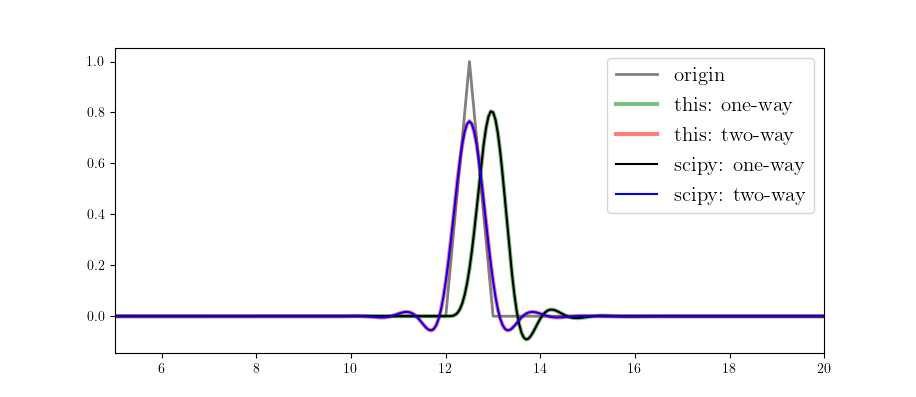1
2
3
4
5
6
7
8
9
10
11
12
13
14
15
16
17
18
19
20
21
22
23
24
25
26
27
28
29
30
31
32
33
34
35
36
37
38
39
40
41
42
43
44
45
46
47
48
49
50
51
52
53
54
55
56
57
58
|
import numpy as np
import matplotlib.pyplot as plt
from scipy.signal import iirfilter, zpk2sos, sosfilt
from scipy import fft
def lowpass(d, fs, fc, orders=4, zerophase=False, taper=0.01):
n = len(d)
fd = fft.fft(d)
f = np.arange(n) * fs / n
w = 2 * np.pi * f / fs
wc = 2 * np.pi * fc / fs
k = np.arange(2*orders)
if orders % 2 == 0:
q = np.tan(wc/2) * np.exp(1j*(k+0.5)/orders*np.pi)
else:
q = np.tan(wc/2) * np.exp(1j*k/orders*np.pi)
p = (1 + q) / (1 - q)
z = np.exp(1j*w)
h = np.ones_like(w, dtype=complex)
for pp in p[abs(p)<1]:
h *= ((1-pp) / (1-pp/z))
h *= ( (1+1/z) ** orders / 2**orders )
dd = fft.ifft(fd * h).real
if zerophase:
dd = fft.ifft(fft.fft(dd[::-1])*h)[::-1].real
ni = int(n*taper)
k1 = np.arange(ni)
k2 = (-k1)[::-1]
ta1 = np.cos(np.pi*k1/ni/2) ** N
ta2 = np.cos(np.pi*k2/ni/2) ** N
dd[:ni] *= ta2
dd[-ni:] *= ta1
return f, h, dd
n = 500
dt = 0.05
t = np.arange(n) * dt
fs = 1 / dt
fc = 1
N = 4
d1 = np.zeros(n)
d1[n//2-10: n//2+1] = 1/10*np.arange(n//2-10, n//2+1) + (20-n)/20
d1[n//2: n//2+11] = -1/10*np.arange(n//2, n//2+11) + (20+n)/20
f, h, d3 = lowpass(d1, fs, fc, orders=N, zerophase=True, taper=0.01)
_, _, d2 = lowpass(d1, fs, fc, orders=N, zerophase=False, taper=0.01)
z, p, k = iirfilter(N, 2*fc/fs, btype='lowpass', ftype='butter', output='zpk')
sos = zpk2sos(z, p, k)
d4 = sosfilt(sos, d1)
d5 = sosfilt(sos, d4[::-1])[::-1]
plt.figure(figsize=(10, 5))
plt.plot(t, d1, 'gray', lw=2, label='origin')
plt.plot(t, d2, 'g', lw=3, label='this: one-way', alpha=0.5)
plt.plot(t, d3, 'r', lw=3, label='this: two-way', alpha=0.5)
plt.plot(t, d4, 'k', lw=1.5, label='scipy: one-way')
plt.plot(t, d5, 'b', lw=1.5, label='scipy: two-way')
plt.legend(fontsize=15)
plt.show()
|

